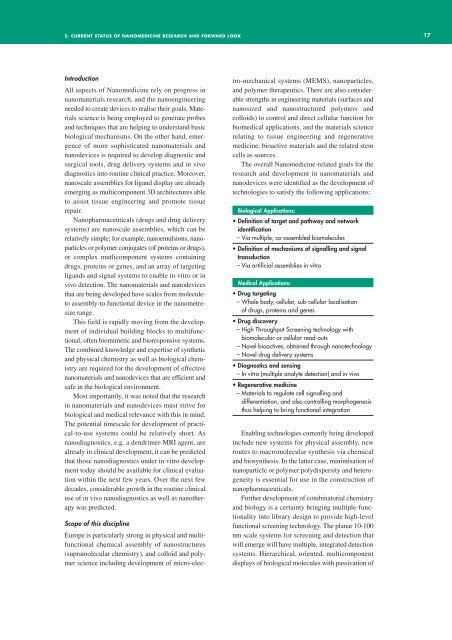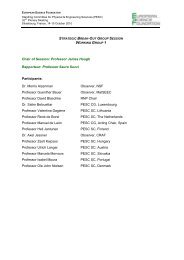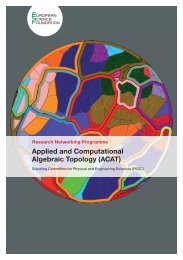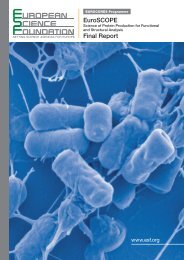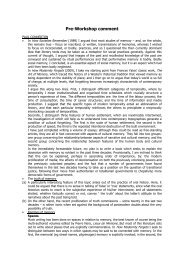Nanomedicine - European Science Foundation
Nanomedicine - European Science Foundation
Nanomedicine - European Science Foundation
You also want an ePaper? Increase the reach of your titles
YUMPU automatically turns print PDFs into web optimized ePapers that Google loves.
2. CURRENT STATUS OF NANOMEDICINE RESEARCH AND FORWARD LOOK 17<br />
Introduction<br />
All aspects of <strong>Nanomedicine</strong> rely on progress in<br />
nanomaterials research, and the nanoengineering<br />
needed to create devices to realise their goals. Materials<br />
science is being employed to generate probes<br />
and techniques that are helping to understand basic<br />
biological mechanisms. On the other hand, emergence<br />
of more sophisticated nanomaterials and<br />
nanodevices is required to develop diagnostic and<br />
surgical tools, drug delivery systems and in vivo<br />
diagnostics into routine clinical practice. Moreover,<br />
nanoscale assemblies for ligand display are already<br />
emerging as multicomponent 3D architectures able<br />
to assist tissue engineering and promote tissue<br />
repair.<br />
Nanopharmaceuticals (drugs and drug delivery<br />
systems) are nanoscale assemblies, which can be<br />
relatively simple; for example, nanoemulsions, nanoparticles<br />
or polymer conjugates (of proteins or drugs),<br />
or complex mutlicomponent systems containing<br />
drugs, proteins or genes, and an array of targeting<br />
ligands and signal systems to enable in vitro or in<br />
vivo detection. The nanomaterials and nanodevices<br />
that are being developed have scales from moleculeto<br />
assembly-to functional device in the nanometresize<br />
range.<br />
This field is rapidly moving from the development<br />
of individual building blocks to multifunctional,<br />
often biomimetic and bioresponsive systems.<br />
The combined knowledge and expertise of synthetic<br />
and physical chemistry as well as biological chemistry<br />
are required for the development of effective<br />
nanomaterials and nanodevices that are efficient and<br />
safe in the biological environment.<br />
Most importantly, it was noted that the research<br />
in nanomaterials and nanodevices must strive for<br />
biological and medical relevance with this in mind.<br />
The potential timescale for development of practical-to-use<br />
systems could be relatively short. As<br />
nanodiagnostics, e.g. a dendrimer-MRI agent, are<br />
already in clinical development, it can be predicted<br />
that those nanodiagnostics under in vitro development<br />
today should be available for clinical evaluation<br />
within the next few years. Over the next few<br />
decades, considerable growth in the routine clinical<br />
use of in vivo nanodiagnostics as well as nanotherapy<br />
was predicted.<br />
Scope of this discipline<br />
Europe is particularly strong in physical and multifunctional<br />
chemical assembly of nanostructures<br />
(supramolecular chemistry), and colloid and polymer<br />
science including development of micro-electro-mechanical<br />
systems (MEMS), nanoparticles,<br />
and polymer therapeutics. There are also considerable<br />
strengths in engineering materials (surfaces and<br />
nanosized and nanostructured polymers and<br />
colloids) to control and direct cellular function for<br />
biomedical applications, and the materials science<br />
relating to tissue engineering and regenerative<br />
medicine, bioactive materials and the related stem<br />
cells as sources.<br />
The overall <strong>Nanomedicine</strong>-related goals for the<br />
research and development in nanomaterials and<br />
nanodevices were identified as the development of<br />
technologies to satisfy the following applications:<br />
Biological Applications:<br />
• Definition of target and pathway and network<br />
identification<br />
– Via multiple, co-assembled biomolecules<br />
• Definition of mechanisms of signalling and signal<br />
transduction<br />
– Via artificial assemblies in vitro<br />
Medical Applications:<br />
• Drug targeting<br />
– Whole body, cellular, sub-cellular localisation<br />
of drugs, proteins and genes<br />
• Drug discovery<br />
– High Throughput Screening technology with<br />
biomolecular or cellular read-outs<br />
– Novel bioactives, obtained through nanotechnology<br />
– Novel drug delivery systems<br />
• Diagnostics and sensing<br />
– In vitro (multiple analyte detection) and in vivo<br />
• Regenerative medicine<br />
– Materials to regulate cell signalling and<br />
differentiation, and also controlling morphogenesis<br />
thus helping to bring functional integration<br />
Enabling technologies currently being developed<br />
include new systems for physical assembly, new<br />
routes to macromolecular synthesis via chemical<br />
and biosynthesis. In the latter case, minimisation of<br />
nanoparticle or polymer polydispersity and heterogeneity<br />
is essential for use in the construction of<br />
nanopharmaceuticals.<br />
Further development of combinatorial chemistry<br />
and biology is a certainty bringing multiple-functionality<br />
into library design to provide high-level<br />
functional screening technology. The planar 10-100<br />
nm scale systems for screening and detection that<br />
will emerge will have multiple, integrated detection<br />
systems. Hierarchical, oriented, multicomponent<br />
displays of biological molecules with passivation of


